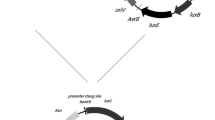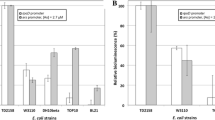Abstract
Target specific biosensor Escherichia coli strains have been engineered for studying the stress action. Four different recombinant E. coli biosensors were constructed by fusing one promoter each of ung, rseA, ibpA, and yggX gene in pET-21a::lacZ system, which contains very effective color-readout sensing system. The responses of four bacteria sensor strains, UNGLacZ, RSEALacZ, IBPALacZ, and YGGXLacZ, have been characterized under treatment with mitomycin C (MMC), phenol, ethanol and hydrogen peroxide (H2O2), respectively. UNGLacZ responded strongly only to MMC (DNA damaging chemical), whereas no response has been observed with phenol, which is a membrane damage chemical. However, RSEALacZ gave significant response with phenol. In addition, ethanol and hydrogen peroxide caused dose-dependent induction from IBPALacZ and YGGXLacZ, respectively. Thus, the results of the present study demonstrate that four bacterial strains show significant and different responses based on various stress defense mechanisms, which these genes originally possessed in E. coli. The four bacterial biosensors can be potentially used in environmental Point-of-Care Testing (ePOCT) leading to quick, easy and early detection of toxic contaminants locally as well as resulting in real-time measurements.
Similar content being viewed by others
References
Rakow, N. A. & Suslick, K. S. A colorimetric sensor array for odour visualization. Nature 406:710–713 (2000).
Jouanneau, S., Durand, M. J. & Thouand, G. Online Detection of Metals in Environmental Samples: Comparing Two Concepts of Bioluminescent Bacterial Biosensors. Environ Sci Technol 46:11979–11987 (2012).
Scheller, F. et al. Biosensors: fundamentals, applications and trends. Sensor Actuat B-Chem 4:197–206 (1991).
Vanrolleghem, P. A., Kong, Z., Rombouts, G. & Verstraete, W. An Online Respirographic Biosensor for the Characterization of Load and Toxicity of Wastewaters. J Chem Technol Biot 59:321–333 (1994).
Paitan, Y. et al. On-line and in situ biosensors for monitoring environmental pollution. Biotechnol Adv 22:27–33 (2003).
Daunert, S. et al. Genetically engineered whole-cell sensing systems: coupling biological recognition with reporter genes. Chem Rev 100:2705–2738 (2000).
Kohler, S., Belkin, S. & Schmid, R. D. Reporter gene bioassays in environmental analysis. Fresenius J Anal Chem 366:769–779 (2000).
Scott, D. L., Ramanathan, S., Shi, W., Rosen, B. P. & Daunert, S. Genetically engineered bacteria: electrochemical sensing systems for antimonite and arsenite. Anal Chem 69:16–20 (1997).
Klein, J., Altenbuchner, J. & Mattes, R. Genetically modified Escherichia coli for colorimetric detection of inorganic and organic Hg compounds. Exs 80:133–151 (1997).
Ogasawara, H. et al. Negative regulation of DNA repair gene (ung) expression by the CpxR/CpxA two-component system in Escherichia coli K-12 and induction of mutations by increased expression of CpxR. J Bacteriol 186:8317–8325 (2004).
Bennett, S. E., Sung, J.-S. & Mosbaugh, D. W. Fidelity of uracil-initiated base excision DNA repair in DNA polymerase ß-proficient and-deficient mouse embryonic fibroblast cell extracts. J Biol Chem 276:42588–42600 (2001).
Missiakas, D., Mayer, M. P., Lemaire, M., Georgopoulos, C. & Raina, S. Modulation of the Escherichia coli sigmaE (RpoE) heat-shock transcription-factor activity by the RseA, RseB and RseC proteins. Mol Microbiol 24:355–371 (1997).
Ades, S. E., Grigorova, I. L. & Gross, C. A. Regulation of the alternative sigma factor sigma (E) during initiation, adaptation, and shutoff of the extracytoplasmic heat shock response in Escherichia coli. J Bacteriol 185:2512–2519 (2003).
Allen, S. P., Polazzi, J. O., Gierse, J. K. & Easton, A. M. 2 Novel Heat-shock genes encoding proteins produced in response to heterologous protein extression in Escherichia-coli. J Bacteriol 174:6938–6947 (1992).
Thomas, J. G. & Baneyx, F. Roles of the Escherichia coli small heat shock proteins IbpA and IbpB in thermal stress management: Comparison with ClpA, ClpB, and HtpG in vivo. J Bacteriol 180:5165–5172 (1998).
Pomposiello, P. J., Koutsolioutsou, A., Carrasco, D. & Demple, B. SoxRS-regulated expression and genetic analysis of the yggX gene of Escherichia coli. J Bacteriol 185:6624–6632 (2003).
Iyer, V. N. & Szybalski, W. A Molecular Mechanism of Mitomycin Action-Linking of Complementary DNA strands. Proc Natl Acad Sci USA 50:355-&(1963).
Paulus, W. Microbicides for the protection of materials (1993).
Choi, S. H. & Gu, M. B. Phenolic toxicity—detection and classification through the use of a recombinant bioluminescent Escherichia coli. Environ Toxicol Chem 20:248–255 (2001).
Grigorova, I. L. et al. Fine-tuning of the Escherichia coli sigmaE envelope stress response relies on multiple mechanisms to inhibit signal-independent proteolysis of the transmembrane anti-sigma factor, RseA. Genes Dev 18:2686–2697 (2004).
Demple, B. Regulation of bacterial oxidative stress genes. Annu Rev Genet 25:315–337 (1991).
King, J. M. et al. Rapid, sensitive bioluminescent reporter technology for naphthalene exposure and biodegradation. Science 249:778–781 (1990).
Zhang, D. et al. Whole-cell bacterial bioreporter for actively searching and sensing of alkanes and oil spills. Microb Biotechnol 5:87–97 (2012).
Lee, A. S. et al. Whole-cell sensing for a harmful bloom-forming microscopic alga by measuring antibody—antigen forces. IEEE Trans Nanobioscience 5:149–156 (2006).
Shetty, R. S. et al. Luminescence-based whole-cellsensing systems for cadmium and lead using genetically engineered bacteria. Anal Bioanal Chem 376:11–17 (2003).
Antonelli, M. L., Campanella, L. & Ercole, P. Lichenbased biosensor for the determination of benzene and 2-chlorophenol: microcalorimetric and amperometric investigations. Anal Bioanal Chem 381:1041–1048 (2005).
Wang, P., Ni, Y. & Kokot, S. A novel dsDNA/polydiphenylamine-4-sulfonic acid electrochemical biosensor for selective detection of the toxic catechol and related DNA damage. Analyst 138:1141–1148 (2013).
Author information
Authors and Affiliations
Corresponding authors
Additional information
These authors contributed equally to this work.
Rights and permissions
About this article
Cite this article
Sekhon, S.S., Ahn, JY., Ahn, JM. et al. Stress specific Escherichia coli biosensors based on gene promoters for toxicity monitoring. Mol. Cell. Toxicol. 10, 369–377 (2014). https://doi.org/10.1007/s13273-014-0041-8
Received:
Accepted:
Published:
Issue Date:
DOI: https://doi.org/10.1007/s13273-014-0041-8




